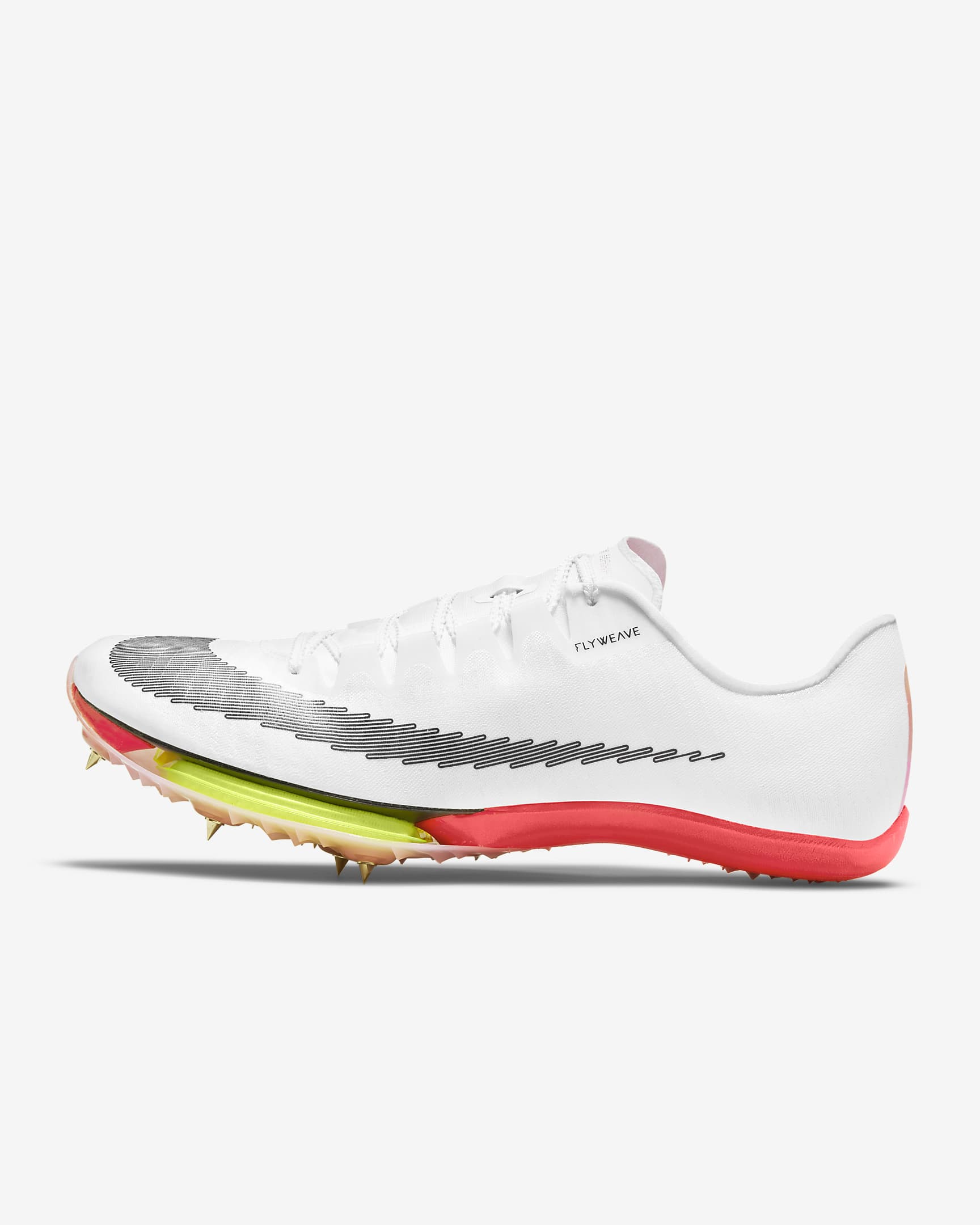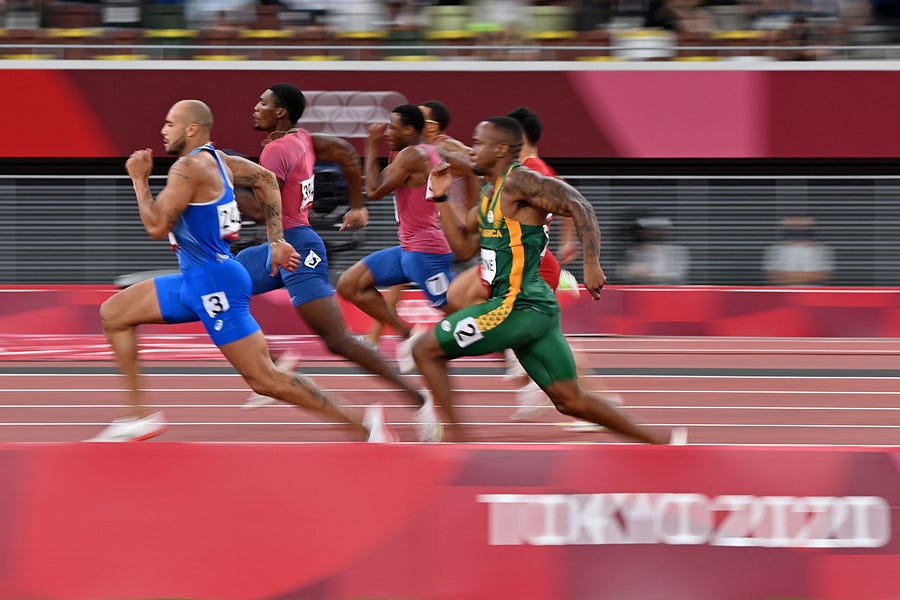American sprinter Fred Kerley became the 15th fastest man in the history of the 100 meter dash last Sunday. He ran the fastest race of his life in the Olympic final: 100 meters in only 9.84 seconds. Given that the average adult reads about 200 to 250 words a minute, Kerley ran 100 meters faster than it will probably take you to get to the end of this sentence, faster than almost every other person who has ever existed, faster than all but 14 people who have ever set foot on a track. And he lost.
By .04 seconds.
Italian runner Lamont Marcell Jacobs Jr. won in 9.80 seconds, making him the 10th fastest man ever. With such small differences in times representing such huge differences in outcome, sprinting is all about finding the slightest edge. Being a world class athlete is part natural ability, part science, and part technology. And in running in particular, maximizing performance means wearing the right shoes.
Gone are the days where Jim Thorpe could throw on a pair of mismatched, poorly fitting shoes from the trash and still beat the competition: If you want to win races at the highest level, you need the latest in shoe tech. And when Lamont Marcell Jacobs ran ever so slightly faster than Fred Kerley on Sunday, he was sporting a shoe packed with the fruits of years of R&D, the Nike Air Zoom Maxfly.
The Maxfly is an electric looking shoe: the pair Jacobs wore when he won gold is white with a massive black Nike swoosh emblazoned across the outer sides and front and a bright pink and green sole. It’s just one in the latest generation of running shoes, controversial so-called “super shoes”—high-tech footwear designed to enhance performance to a degree never before seen. Dr. Zach Thomas is a podiatrist who runs a YouTube channel where he reviews and dissects athletic shoes, showing off the technology that goes into them. He says that the Maxfly is unlike any running shoe that came before it: “The energy return per ounce of the shoe is so much higher than a traditional plastic and foam shoe.”
Previous generations of sprinter’s cleats were designed to be minimalist and utilized plastic plates and thinner soles, but the Maxfly and other super shoes incorporate a carbon fiber plate and a layer of cushioning foam. Thomas explained that thick foam in the heel of the Maxfly acts like a spring, thrusting the runner forward, while a carbon fiber plate provides a rigid surface for the reverberated energy created from the shoe hitting the ground to push back against, propelling the runner off of the ground with greater energy. Beneath the spikes at the front of the shoe are dual chambered Nike Air units—hollow pockets inside the sole that compress upon contact, then spring back into shape, creating a trampoline effect that pushes the shoe off the ground with more energy. The Air units plus the carbon fiber plates yield an even larger energy return.
“You have an Air Zoom unit producing all this buoyancy and bounce in the forefoot,” said Thomas. “But now you have this carbon fiber plate right behind it, so all the potential energy that is stored in those Air Zoom units when you compress them, now that can change into more kinetic energy because that carbon fiber plate is like a rigid beam for all that energy to be pushed out into.”

The Air Zoom Maxfly was just released earlier this year but has already seen impressive results in competition for both men and women. Elaine Thompson-Herah won the 100 meter dash for women in 10.61 seconds, the second fastest time recorded while wearing them. (The world record of 10.49 seconds set by the late Florence Griffith-Joyner in 1988 is the subject of some controversy, with it being suggested that there were high wind speeds that were improperly measured.) Same for silver medalist Shelly-Ann Fraser-Pryce. Similar shoes produced by Nike have already set records in longer races too; the men’s and women’s 5,000 meter and 10,000 meter races were won in world-record times by Nike athletes, and college and high school athletes are setting records with Nike’s special spikes.
That runners with the Maxfly are seeing such impressive results has spurred some controversy, with athletes—including 100 meter world record holder Usain Bolt—criticizing the level to which the shoes can make up for lesser talent or training. And given the fact that Nike seems to be leading in this field by a large margin at this point, some athletes worry that until their sponsors catch up they’ll be at a disadvantage. The margin is so wide at this point that some brands are actually letting their runners wear Nike’s shoes instead until they can produce something similar.
A similar controversy occurred in longer-distance running after Nike introduced similar technology in marathon shoes a few years ago, and at the time Fred Kerley wrote off complaints about the shoes, saying, “Shoes don’t make nobody run fast.” He’s right: It still takes a lot of hard work and raw talent to get to the highest echelon of running, shoes alone won’t make slow runners fast. But when Kerley showed up Sunday and ran the fastest race of his life, before taking his place at the starting line he laced up his pair of Nike Air Zoom Maxfly. Shoes won’t make you fast. But they can make you faster.







Please note that we at The Dispatch hold ourselves, our work, and our commenters to a higher standard than other places on the internet. We welcome comments that foster genuine debate or discussion—including comments critical of us or our work—but responses that include ad hominem attacks on fellow Dispatch members or are intended to stoke fear and anger may be moderated.
With your membership, you only have the ability to comment on The Morning Dispatch articles. Consider upgrading to join the conversation everywhere.